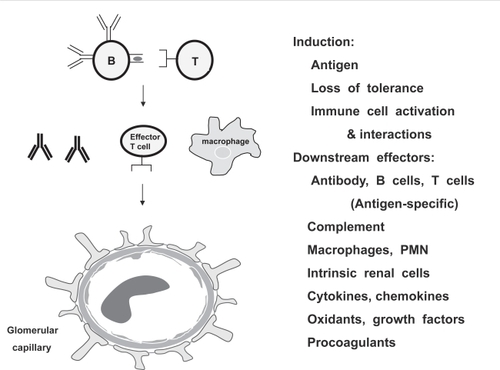Figures & data
Table 1 Common glomerulonephritides and glomerulopathies with immune origins
Table 2 Current common nonspecific therapies for glomerulo-nephritis
Table 3 Potential immunotherapy in autoimmunity and glomeru-lonephritis (after CitationFoster 2007)
Figure 1 Pathogenesis of glomerulonephritis. Animal models suggest that autoimmunity underlies pathogenesis of most GN. Disease initiation requires loss of tolerance and activation of self-reactive lymphocytes. Activated B and T cells interact to promote autoantibody and cytokine production, immune complex formation, antibody deposition, macrophage and neutrophil recruitment, renal inflammation, and activation of renal endothelial, mesangial, epithelial and tubular cells. Glomerular and tubulointerstitial antigens may be specifically targeted by autoantibodies and self-reactive CD4 and CD8 TCR alpha/beta effector T cells, gamma/delta T cells and NKT cells. Numerous soluble and cellular mediators participate in subsequent tissue inflammation, injury and repair, and modulate local renal immune responses. The predominant cells and molecules engaged vary depending on the etiology and site of glomerular injury.

Table 4 Antigen targets in immune-mediated glomerular injury